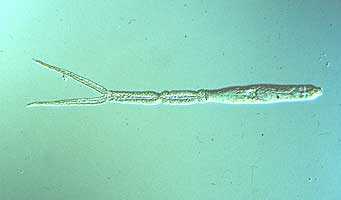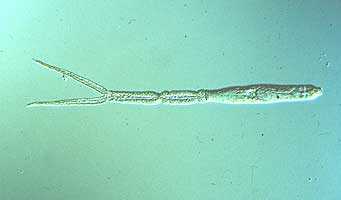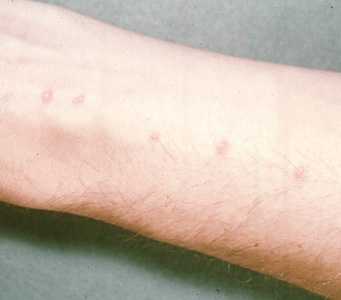
Cercarial Dermatitis
Causal Agents
Cercarial dermatitis is caused by the cercariae of certain species of schistosomes whose normal hosts are birds and mammals other than humans. These cercariae seem to have a chemotrophic reaction to secretions from the skin and are not as host-specific as other types of schistosomes. They attempt to, and, sometimes may actually, enter human skin. The penetration causes a dermatitis which is usually accompanied with intense itching, but the cercariae do not mature into adults in the human body. Cases of cercarial dermatitis can occur in both fresh and brackish water environments. One species of schistosome often implicated in cases of cercarial dermatitis is Austrobilharzia variglandis, whose normal hosts are ducks. The snail, Nassarius obsoletus, is the intermediate host for this species and can be found at marine beaches in temperate climates. Cercarial dermatitis should not be confused with seabather's eruption, which is caused by the larval stage of cnidarians (e.g., jellyfish). The areas of skin affected by seabather's eruption is generally under the garments worn by bathers and swimmers where the organisms are trapped after the person leaves the water. Cercarial dermatitis occurs on the exposed skin outside of close-fitting garments.
Life Cycle

Hosts of avian schistosomes can be either year-round resident or migratory birds, including seagulls, shorebirds, ducks, and geese. Adult worms are found in the blood vessels and produce eggs that are passed in the feces  On exposure to water, the eggs hatch and liberate a ciliated miracidium that infects a suitable snail (gastropod) intermediate host.
On exposure to water, the eggs hatch and liberate a ciliated miracidium that infects a suitable snail (gastropod) intermediate host.  . The parasite develops in the intermediate host
. The parasite develops in the intermediate host  to produce free-swimming cercariae that are released under appropriate conditions and penetrate the skin of the birds and migrate to the blood vessels to complete the cycle
to produce free-swimming cercariae that are released under appropriate conditions and penetrate the skin of the birds and migrate to the blood vessels to complete the cycle  . Humans are inadvertent and inappropriate hosts; cercariae may penetrate the skin but do not develop further
. Humans are inadvertent and inappropriate hosts; cercariae may penetrate the skin but do not develop further  . A number of species of trematodes with dermatitis-producing cercariae have been described from both freshwater and saltwater environments, and exposure to either type of cercaria will sensitize persons to both.
. A number of species of trematodes with dermatitis-producing cercariae have been described from both freshwater and saltwater environments, and exposure to either type of cercaria will sensitize persons to both.
Geographic Distribution
Cercarial dermatitis occurs worldwide with cases reported from every continent except Antarctica. In the United States, cases are commonly reported from the Great Lakes region.
Clinical Presentation
Cercarial dermatitis (swimmer's itch) is a cutaneous inflammatory response usually associated with penetration of the skin by cercariae of bird schistosomes. Symptoms include reddening and itching of exposed skin in the water or immediately after emerging. This is an indication of initial penetration of the cercariae. After a period of approximately 12 hours, pruritic papules may become vesicular. Scratching the affected areas may result in secondary bacterial infections. An interesting note is that previous contact with cercariae can lead to a more immediate and intense immune response.
Cercaria of Austrobilharzia variglandis.

Figure A: Cercaria of Austrobilharzia variglandis, which can cause cercarial dermatitis.

Figure B: Cercaria of Austrobilharzia variglandis, which can cause cercarial dermatitis. Note the forked 'tail' and a pair of 'eye spots' near the anterior end.
Clinical manifestations of cercarial dermatitis

Figure A: Skin of a patient showing the inflammatory response to cercaria in the skin.
Laboratory Diagnosis
Cercarial dermatitis is usually diagnosed based on symptoms and not laboratory analyses of clinical specimens. Rarely investigations into the causal agent occur during outbreaks. In these cases, specific snails that would be suitable hosts for these particular avian schistosomes need to be collected from the area where cases of cercarial dermatitis have been reported. The snails need to be checked to verify if they are shedding cercariae by standard methodology. Sunlight may be preferred over using artificial light to stimulate shedding. Another method is to crush the snails and examine the body for parasite sporocysts and/or cercariae. The cercariae then must be identified as being a type that can cause cercarial dermatitis by using appropriate reference material.
Treatment Information
The allergic reaction to penetrating cercariae is self-limiting; signs and symptoms usually will resolve within 1-2 weeks. Minimal symptomatic treatment and good hygiene to prevent itching and secondary infections are usually sufficient treatment for most cases of cercarial dermatitis.
Treatment of cercarial dermatitis has not been evaluated in clinical trials. Systemic antihistamines or topical antihistamines or corticosteroids can be used to reduce symptoms. Topical antiseptics or antibiotics as well as systemic antibiotics may be needed in the case of secondary infection.
References
- Caumes E, Felder-Moinet S, Couzigou C, Darras-Joly C, Latour P, Léger N.. Failure of an ointment based on IR3535 (ethyl butylacetylaminopropionate) to prevent an outbreak of cercarial dermatitis during swimming races across Lake Annecy, France. Annals Trop Med Parasitol 2003:97:157-63.
- Chamot E, Toscani L, Rougemont A. Public health importance and risk factors for cercarial dermatitis associated with swimming in Lake Leman at Geneva, Switzerland. Epidemiol Infect 1998:120:305-4.
- Hoeffler DF. "Swimmers' itch" (cercarial dermatitis). Cutis 1977;19:461-7.
DPDx is an education resource designed for health professionals and laboratory scientists. For an overview including prevention and control visit www.cdc.gov/parasites/.
- Page last reviewed: May 3, 2016
- Page last updated: May 3, 2016
- Content source:
- Global Health – Division of Parasitic Diseases and Malaria
- Notice: Linking to a non-federal site does not constitute an endorsement by HHS, CDC or any of its employees of the sponsors or the information and products presented on the site.
- Maintained By:


 ShareCompartir
ShareCompartir